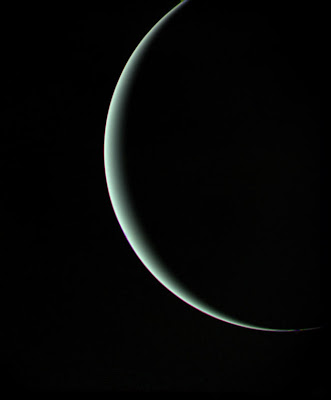 An interesting day in astronomy. The Minister of Space Exploration is pleased to say that two articles were recently published, announcing the discovery of four exoplanets around two stars. The announcement of exoplanets, in and of itself, isn't terribly newsworthy; after all, over 300 have been discovered so far. What make these four stand out is that all of them have been observed visually; that's newsworthy.
An interesting day in astronomy. The Minister of Space Exploration is pleased to say that two articles were recently published, announcing the discovery of four exoplanets around two stars. The announcement of exoplanets, in and of itself, isn't terribly newsworthy; after all, over 300 have been discovered so far. What make these four stand out is that all of them have been observed visually; that's newsworthy.In the first article, published by Science, a star 128 light years away, designated HR 8799 and located in the constellation of Pegasus, was found to have three exoplanets orbiting it (labeled b, c and d in the photograph). The planets appear to be between five to ten times the mass of Jupiter, with the closest planet being the smallest and the furthest planet being the largest, somewhat like our solar system. The planets were imaged in infrared radiation and are still glowing with the original heat from their creation roughly 60 million years ago. (The Earth, by contrast, is 4.5 billion years old.)
The other exoplanet recently discovered orbits Fomalhaut, a star only 25 light years away from Earth, located in the constellation Piscis Australis, or the "Southern Fish." NASA reports:

In 2004, the coronagraph in the High Resolution Camera on Hubble's Advanced Camera for Surveys produced the first-ever resolved visible-light image of the region around Fomalhaut. (Note: A coronagraph is a device that can block the bright light of a central star to reveal faint objects around it.) It clearly showed a ring of protoplanetary debris approximately 21.5 billion miles across and having a sharp inner edge.
This large debris disk is similar to the Kuiper Belt, which encircles the solar system and contains a range of icy bodies from dust grains to objects the size of dwarf planets, such as Pluto.
Hubble astronomer Paul Kalas, of the University of California at Berkeley, and team members proposed in 2005 that the ring was being gravitationally modified or "shepherded" by a planet lying between the star and the ring's inner edge.
Now, Hubble has actually photographed a point source of light lying 1.8 billion miles inside the ring's inner edge.
...
Observations taken 21 months apart by Hubble's Advanced Camera for Surveys' coronagraph show that the object is moving along a path around the star, and is therefore gravitationally bound to it. The planet is 10.7 billion miles from the star, or about 10 times the distance of the planet Saturn from our sun.
The planet is brighter than expected for an object of three Jupiter masses. One possibility is that it has a Saturn-like ring of ice and dust reflecting starlight. The ring might eventually coalesce to form moons. The ring's estimated size is comparable to the region around Jupiter and its four largest orbiting satellites.
Kalas and his team first used Hubble to photograph Fomalhaut in 2004, and made the unexpected discovery of its debris disk. At the time they noted a few bright sources in the image as planet candidates. A follow-up image in 2006 showed that one of the objects had changed position since the 2004 exposure. The amount of displacement between the two exposures corresponds to an 872-year-long orbit as calculated from Kepler's laws of planetary motion.
To give an idea of how large an 872-year orbit is, the dwarf planet Pluto orbits the sun once every 248 years (about 28% of the time Fomalhaut b takes); the dwarf planet Eris orbits the sun once every 557 years (about 64% of Fomalhaut b's orbit).
Of course, none of these four exoplanets may actually qualify as being the first seen visually; the Minister reported on a possible exoplanet being seen in mid-September.
--------------------
One other article of note. In an article on the evolution of rocks and minerals, The Economist notes:
Understanding just how dramatically life shapes minerals will play an important role in the exploration of the universe, says Dr Hazen. Knowing which minerals form at different stages of a planet’s evolution, and which depend upon life to be present, are crucial to understanding the mineralogy of other planets and moons.
With NASA’s Messenger probe now going into orbit around Mercury, Dr Hazen predicts that it will find only 300 or so minerals on the planet. If there are 500-1,000 detected, then it will suggest that there is a lot more to Mercury than anyone originally thought. And if minerals that depend upon life for their formation show up, then researchers will be flummoxed. The same is true for Mars and other planets—including the exoplanets that have been known about but which have just been seen for the first time orbiting stars outside the Solar System. Dr Hazen argues that considering minerals in evolutionary terms is a powerful way to help identify how far a planet has developed geologically. Moreover it can tell you whether life was present at some point—and even whether it is present now.
Photo Credits: Of the HR 8799 system, The Economist; of the Fomalhaut system, NASA, ESA, P. Kalas, J. Graham, E. Chiang, E. Kite (Univ. California, Berkeley), M. Clampin (NASA/Goddard), M. Fitzgerald (Lawrence Livermore NL), K. Stapelfeldt, J. Krist (NASA/JPL), courtesy of APOD





















